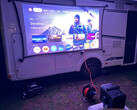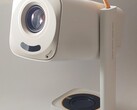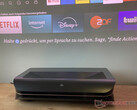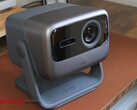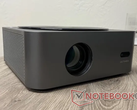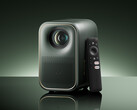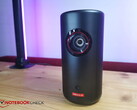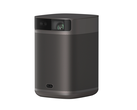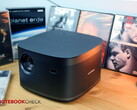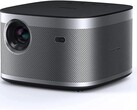
Impressive 4K laser projector with optional 4.1.2 sound: Anker Nebula X1 in a practical test
Brilliant.
3,500 ANSI lumens bright 4K image packed into a portable housing - the Nebula X1 from Anker is an impressive and versatile 4K laser projector. Our Nebula X1 test reveals what it can and cannot do.Marcus Schwarten (translated by DeepL / Marcus Schwarten) Published 🇩🇪 🇫🇷 ...
Nebula X1 test conclusion: Brilliant, but not cheap
The Nebula X1 is an impressive 4K projector, but it also has a proud price tag. Including the accessory set with the highly recommended satellite speakers, it almost reaches the mark of $4,000.
For the money, however, you get a technically sophisticated projector with a bright and razor-sharp 4K image that aligns and optimizes itself. If you can't or don't want to permanently install a projector at home, the Nebula X1 is an excellent alternative that is easy to set up and easy to put away after use.
At a good 6 kg and without battery, the X1 is not particularly mobile, but can also be used for outdoor home cinema evenings in combination with a power station. Overall, the Nebula X1 delivers a remarkable performance for a portable projector at a high but reasonable price.
Pros
Cons
Price and availability
The recommended retail price for the Nebula X1 is $2,999.99. It is available from Amazon or directly from the manufacturer.
Anker has launched the flagship X1 model with its Nebula projector brand a few months ago. At $3,000 RRP, the 4K laser projector is anything but a bargain, but it also offers impressive features.
We tested the Nebula X1 in practice for a few weeks and put it through various challenges in different scenarios, from indoors to outdoors. Our Nebula X1 test reveals how good the 4K projector is and whether it's worth buying.
Data sheet Nebula X1
| Resolution: | 4K / UHD (3,840 x 2,160 pixels) |
| Projection ratio: | 0.9-1.5:1 |
| Light source (lifetime): | Tri-Color Laser (25,000 hours) |
| Brightness: | 3,500 ANSI lumens |
| Contrast: | 5,000:1 |
| Operating system: | Google TV |
| Connectivity: | HDMI 2.1, USB, audio, Wi-Fi, Bluetooth |
| RRP: | $2,999.99 |
| available at | Amazon and others |
Equipment and setup: Fully automatic image alignment
The Nebula X1 is a 4K projector with tri-color laser technology as the light source. It has an expected service life of 25,000 hours, which means that the device is equipped to last for decades, even if used for two hours a day. So nobody has to worry about replacing a bulb.
At the heart of the X1 is a 14-element all-glass optical system that promises a particularly clear image. It also features the NebulaMaster 2.0 image processing module, ISF certification and Dolby Vision support.
The micro-gimbal in the front enables a tilt of up to 25 percent, which means that the image can be automatically aligned to the screen within a limited range and the projector can also be positioned below the screen.
The motorized zoom (0.9-1.5:1), autofocus and keystone correction enable automatic calibration of the image, which worked well and reliably in the test. This means that the projector always calibrates itself automatically and can be positioned quite freely - ideal for beginners and variable use.
Anker relies on Google TV as the operating system for the Nebula X1. This not only enables access to countless apps including Netflix (certified), Amazon Prime Video, YouTube, Disney+ and more, but also other smart features such as voice control via the Google Assistant.
An illuminated remote control is included in the scope of delivery. There is also a touch-illuminated control unit on the device and the option to control it via the Nebula app.
The smartphone also plays an important role in the initial setup process to set up Google TV. This takes a few minutes, but is well explained. The Nebula X1 is then ready for operation, unless a new firmware update needs to be installed.
In addition to Wi-Fi and Bluetooth (e.g. for headphones) and Google Cast (for transferring content from smartphones and other devices), various connections are available at the rear for connectivity. These include two HDMI 2.1 ports (one with eARC), which can be used to transmit 4K at 60 Hz. This means that the projector is also more than solid for large-format gaming, even if there is no 120 Hz, ALLM and VRR. There is also a USB-C and USB-A port and an audio port.
Picture quality: razor sharp and impressively bright
As a rule, portable projectors do not come close to stationary models. The Nebula X1 is a different story. The premium model from Nebula with a corresponding premium price not only produces a razor-sharp 4K image (not native), but can also be variably aligned. The projection ratio of 0.9-1.5:1 allows a flexible distance to the screen or other projection surface. For example, it can display a 150-inch image at a distance of 3.05 to 4.88 m.
In addition to the subjectively excellent picture quality including remarkable contrast (5000:1), rich blacks and bright colors as well as smooth moving image, the Nebula X1 also impresses with its brightness in the test. The data sheet states 3.500 ANSI lumens. In a darkened room, the Nebula X1 is impressive. Even in daylight, e.g. for watching football on a Sunday afternoon, the brightness is sufficient if the requirements are not too high and there is no direct sunlight.
The Nebula X1 also had to prove itself in our practical test when used outdoors. If the sun shines directly on it, it doesn't stand a chance either.
However, with the right orientation and a smaller projection surface or towards sunset in the evening, the projector delivers a great home cinema experience outdoors that many other portable (but also cheaper) projectors cannot keep up with.
Sound quality: Really good with external speakers
The Nebula X1 itself has four speakers including a subwoofer with a total of 40 W. This provides a solid sound that is better than that of many other mobile projectors.
It gets even better with the two satellite speakers from the optional accessory set. They expand the sound system to 4.1.2 channels and thus provide almost real home theater sound. Positioned to the left and right of the seating position, this creates real surround sound.
In addition, the speakers with their total of four drivers also radiate upwards when Dolby Atmos is present, creating an ambient soundscape that no other portable projector can match. The bass reproduction is solid, even if, like the entire sound system, it cannot compete with a real home theater system with 5.1 or more channels and a large subwoofer. The integrated battery in the speakers lasts around eight hours. The speakers are charged via USB-C.
Energy and volume: no battery, but quiet
Even if the Nebula X1 looks like a mobile projector at first glance, partly due to its extendable carrying handle on the top of the high-quality and robust plastic housing, it is only a mobile projector to a limited extent. Packed with all kinds of technology, the device, which measures around 28 x 19 x 25 cm, weighs a good 6 kg. So the X1 is not really handy.
However, the weight does not include a battery. It simply does not exist. This means that the 4K projector is always dependent on an external power source. If you want to use it outside the home or away from the power grid, you can alternatively use a Power station.
We measured the power consumption of the Nebula X1 in the test at around 160 Wh at the highest brightness level. This means that a two-hour movie requires a good 0.3 kWh of power. Even a compact power station with 500 Wh is therefore sufficient for most movie nights outdoors. If necessary, the energy consumption can be reduced in Eco mode, but at the expense of brightness.
Thanks to the liquid cooling system, which is installed in a projector for the first time, Nebula advertises a noise level of just 26 dB. In practice, the volume was slightly higher at 32 dB, measured at a distance of 50 cm from the projector. Compared to many other portable projectors, the X1 is nevertheless very quiet, but can still be heard through continuous noise, especially in quiet scenes. At higher volume levels, however, the inherent noise is no longer an issue.
Transparency
The selection of devices to be reviewed is made by our editorial team. The test sample was given to the author by the manufacturer free of charge for the purposes of review. There was no third-party influence on this review, nor did the manufacturer receive a copy of this review before publication. There was no obligation to publish this review. As an independent media company, Notebookcheck is not subjected to the authority of manufacturers, retailers or publishers.
















